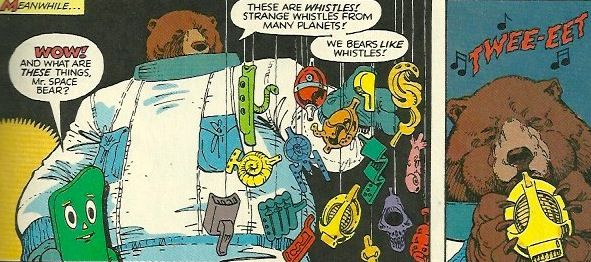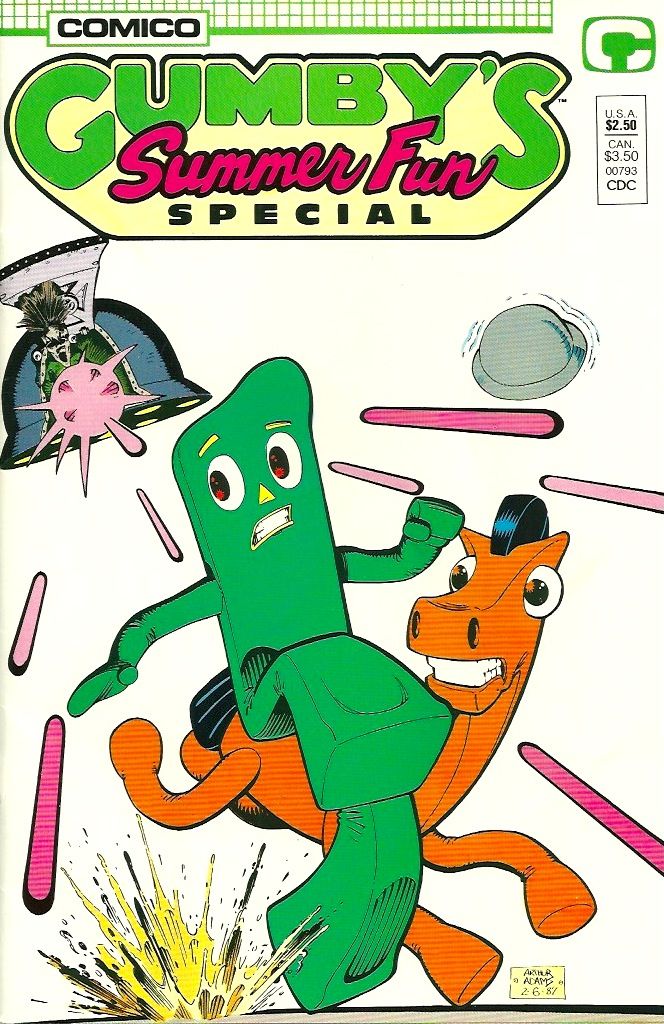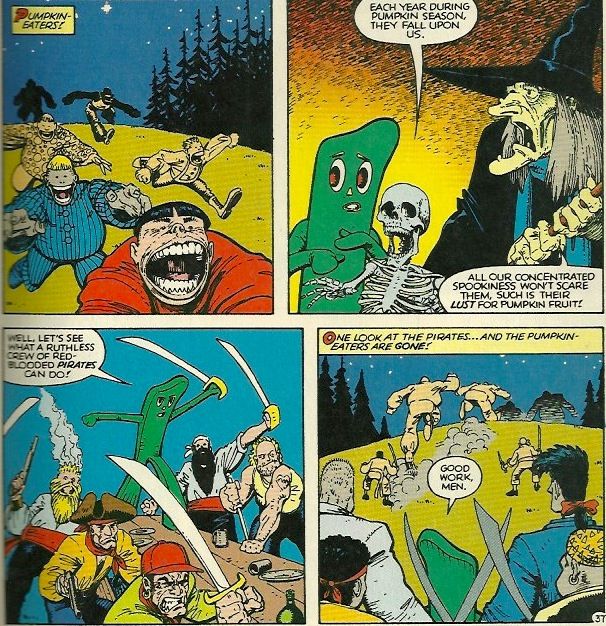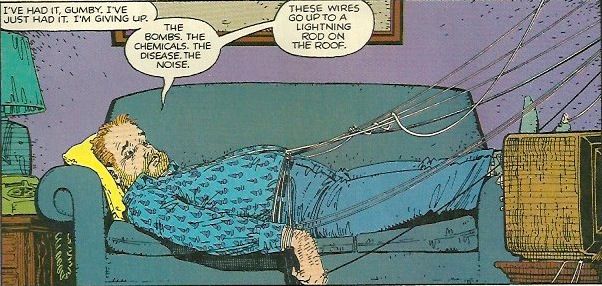A column in which Matt Derman (Comics Matter) reads & reviews comics from 1987, because that’s the year he was born.
Gumby's Summer Fun Special #1 (Comico) by Bob Burden, Arthur Adams, Rick Taylor, L. Lois Buhalis, and Diana Schutz
As an adult, the best kids' entertainment isn't the wholesome educational stuff, but the trippy, bright-colors-and-hypnotic-images nonsense. I don't know if that's the smartest choice of material for the children at whom it is presumably targeted, but the pure, mindless fun and positivity is refreshing as a grown-up. It's an excuse to access the most childlike parts of your brain, to experience something for its insignificance rather than its importance. That's the secret to the success of Gumby's Summer Fun Special #1. It moves the way a child's imagination does, stopping frequently for non-sequiturs and never staying anywhere for very long. It's ADD in comicbook form, but controlled enough to have a semblance of narrative, something to hang onto during the wild ride. With a few weirdly dark moments and a ton of great artwork, the 40-page issue has plenty for older readers, enough that I kind of question whether or not it's even entirely appropriate for kids.
It could not begin with anything more simple or innocent: Gumby and his friends playing kick the can on a beautiful day in the park. This playful merriment lasts two full pages before the can is kicked through the window of Mr. Wooster's house. When Gumby and Pokey go to apologize/investigate, they find Wooster lying on his couch, looking disheveled as hell, attached by wires to a bunch of lightning rods on his roof. It's an inventive method of suicide, though it does require him to wait for a storm, but more importantly it's a sudden and sharp turn for the narrative to take. It's kind of writer Bob Burden to include such a jarring change of direction so early in the issue, because from there on it's pretty much rapid-fire series of mini adventures for Gumby and his friends.
I'm going to try and summarize this as quickly as possible. Gumby and Pokey take Wooster home with them to try and cheer him up, but get interrupted because they have to babysit the three robot kids of Gumby's parents' robot friends while all the adults go out together. Gumby, Pokey, and the robots play for a while, but the youngest robot, Niblet, inadvertently contacts an alien ship, causing the aliens to panic and attack. At the same time, the kids' real
babysitter, an old woman named Mrs. Wardle, arrives at the house and immediately reveals herself to be a werewolf, though we're told even she is unaware of her condition. Luckily, the aliens zap the werewolf into unconsciousness. Unluckily, they also kidnap Niblet. So Gumby and crew gear up to mount a rescue mission, when a group of anthropomorphic astronaut bears shows up, chasing after the original kidnapper aliens, whom the space bears identify as Hysterians. The chase for the Hysterians leads to an island inhabited by pirates where their spaceship has crashed. The island is then attacked by a swarm of Hysterians mounting their own rescue misson, so the space bears, the pirates, and Gumby's gang team up for a final confrontation. The space bears depart, Gumby is elected king of the pirates to replace the one who died in the fight, and everybody sets sail back to America so Gumby and the other children can go home. For good measure, they first accidentally land at Halloweentown, where it's Halloween all the time (of course), and they help the citizens out by scaring off a pack of pumpkin-eaters, which aren't really explained in detail but I guess the name sort of says it all. Anyway, a witch from Halloweentown helps Gumby figure out how to use the crystal ball that belonged to the previous pirate king, and the kids make it home. There they find Wooster, now intensely, almost aggressively happy because he got married. The timeline is a little hazy on that, because the parents then show up as if they were returning from the same night out they left for earlier, but if you're looking for logic by that point, it's too late, because the robot kids go home and the comic ends.
Get all that? It's quite a lot when you type it all out like that, even for a double-sized issue. Burden crams in all those little episodes and frequent random detours, too. A single panel of a kid on the playground firing his cap gun. Or another pointing out that, when they play cowboys and Indians, the girl robot has to be an Indian because she's a girl, but it's ok because she likes being an Indian. Or the little skeleton boy in Halloweentown who sings, Happy boy. Happy boy. I'm a very happy boy. Look at all my beautiful pumpkins! There's so little purpose to the loose plot that does exist, Burden finds as many opportunities as he can to throw in chunks of extra pointlessness just for laughs. Not every one of these joke lands, but there's enough humor in the main story to make up for it. The script is a celebration of absurdity and imagination. It mashes genres together recklessly, and uses as many clichés as original elements. Sometimes it's a combination of the two, like how the space bears fuel their ship with honey. There are just so many ideas in here, big and small, new and old, it's very much like trying to follow the non-narrative of children at play.
This energetic outpouring of story needs to be backed up by flexible, clear artwork that also shares in the spirit of fun. Art Adams provides exactly that. The Hysterians look like they come from a different series than the space bears, which look different than the pirates, who all contrast strongly against Gumby himself. None of them should fit together, yet Adams so confidently and casually uses them in the same space, it still feels like a cohesive reality. And each of them is visually captivating on their own. The Hysterians' eyes are literally popping out of their heads at all times. Mrs. Wardle only has one panel where her human face is visible before she wolfs out, but it's so tired and sad and hollow, you can see that something's deeply wrong with her before her transformation even begins. And then as a werewolf, she's legitimately monstrous, especially her long, multi-jointed, almost spider-like fingers. Ick. The space bears are my personal favorite, just because of the sheer massive size of them. They're so bulky in their old-school space suits and fishbowl helmets. Their vessel is just as large and rotund, and it helps them stand out as the biggest presence in the book. Adams does stellar design work on the whole cast, and it is largely the variety of that cast which moves things along and keeps them interesting.
Part of what makes all these characters work well together is that, while giving them each their own look, Adams draws everyone in a very exaggerated style. Gumby, of course, has his origins in animation, and there is a cartoonish quality to the art that complements that. Rick Taylor's colors have much to do with this as well. Even when the backgrounds are blank, there's never any white space. Taylor saturates the panels with color, nothing so bright as to be garish, but definitely hues that pop more often than not. His palette for this comic has a wide range, so there are a lot of colors on display on every page, since there's always so much going on. Adams and Taylor both put loads of detail into the whole project; the art is as overstuffed as the script. There's a general abundance of awesome involved throughout, is what I'm saying, because all the creators overperform.
My expectations were tempered at best when I cracked open the cover of Gumby's Summer Fun Special #1, but it wound up being a delightful, breezy read. Largely forgettable, maybe, in the long run, if only because there are so many tiny details to hold onto, and none of them matter much more than the others. And as far as whether or not it's truly suited for children, I think any kid who could understand all of it could probably handle it, assuming they don't have a phobia of aliens, bears, pirates, robots, werewolves, skeletons, witches, or Gumby. The most questionable moment as far as that's concerned is probably when Wooster lays out his plan to die, and that plot line also contains the most dangerous moral, that the answer to depression is quickly getting married. Beyond that, though, it's just a goofy epic with lightweight violence and heavy comedy. A fine bit of low-stakes, low-brow reading for all ages.




